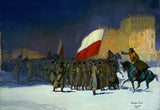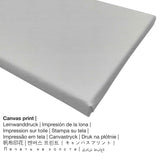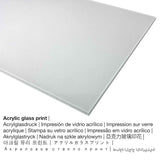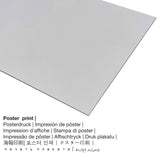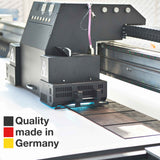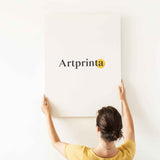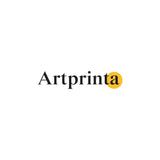George Benjamin Luks, 1918 - Czechoslovakian Army Entering Vladivostok, Siberia, in 1918 - fine art print
Tax included. Shipping calculated at checkout.
Pick your product material
We offer a range of various sizes and materials for every product. In order match your personal requirements perfectly, you can choose among the following product customization options:
- Aluminium dibond print: Aluminium Dibond prints are prints on metal with an impressive depth. A direct Aluminium Dibond Print is the excellent introduction to art prints made with aluminum. For the Direct Print On Aluminum Dibond, we print your selected work of art on the aluminium composite white-primed surface. This print on Aluminum Dibond is one of the most popular entry-level products and is a stylish way to showcase fine art reproductions, since it draws focus on the artwork.
- The acrylic glass print: A glossy acrylic glass print, often named a plexiglass print, will turn an original artwork into wall décor. The major advantage of an acrylic glass print is that contrasts and also image details will be visible thanks to the very subtle tonal gradation. The real glass coating protects your chosen fine art print against light and heat for many more years.
- Poster (canvas material): The poster print is a UV printed cotton canvas with a nice texture on the surface. It is optimally suited for placing your art copy in a customized frame. Please note, that depending on the size of the poster we add a white margin of around 2-6cm around the print to facilitate the framing with a custom frame.
- Canvas: The canvas direct print is a printed cotton canvas stretched on a wooden stretcher. Further, a printed canvas makes a familiar and pleasing atmosphere. The advantage of canvas prints is that they are relatively low in weight, which means that it is quite simple to hang the Canvas print without the use of extra wall-mounts. A canvas print is suitable for all types of walls.
Important information: We try in order to describe the art products as accurately as possible and to display them visually. Still, some colors of the print materials and the print result can diverge to a certain extent from the image on the monitor. Depending on the settings of your screen and the condition of the surface, not all color pigments will be printed 100% realistically. Bearing in mind that all the art reproductions are processed and printed manually, there might also be slight discrepancies in the exact position and the size of the motif.
Original artwork specifications as provided from Los Angeles County Museum of Art website (© Copyright - by Los Angeles County Museum of Art - Los Angeles County Museum of Art)
Artists actively participated in the numerous efforts to raise money for the Allied cause during World War I. As part of the Fourth Liberty Loan Drive, New York’s Fifth Avenue was transformed into an art gallery during October 1918. Paintings devoted to the different Allied nations were displayed in shop windows. During this period Luks was inspired to paint a series of war-related compositions. The Czechoslovakian march through Siberia and the Czechoslovakian drive for independence during the war were causes célèbres that were repeatedly headlined in the newspapers. During the war Czech troops joined the Russians to fight on the side of the Allies. With the withdrawal of Russia from fighting after the signing of the Treaty of Brest-Litowsk in 1918, the Czechs were forced to leave Russia. They marched through Siberia and despite many impediments caused by poor weather and adverse political conditions reached Vladivostok in May 1918. There they boarded ships to journey to France, where they were to join other Allied forces. Luks depicted these soldiers arriving in Vladivostok. Luks no doubt became involved in the Czech cause through his friendship with the sculptor Gutzon Borglum (1871-1941), who had became closely involved in the Czech cause and even permitted his home in Stamford, Connecticut, to be used as a military base for the training of American-born Czech volunteers. Luks visited Borglum during this time and once joined him in painting posters to raise funds for the camp. Although Luks did not see the Czech army advancing in Siberia, he may have observed new soldiers practicing marching and attacking. He depicted the camp in Connecticut at least once, in Czechoslovakians in American Camp Celebrating Their Recognition as a Country, 1918 (unlocated; exhibited Allied War Salon, American Art Association Galleries, New York, 1918). Such an experience enabled Luks to become familiar with the Czech uniforms as depicted in Czech-slovak Chieftain, 1919 (Newark [N.J.] Museum), and also the new country’s flag. Although the red-andwhite striped flag Luks delineated in the museum’s painting is not the design eventually selected for the national flag, it is the one depicted by Henry Rittenberg (1879-1969) in his painting of the Czech army that was carried down Fifth Avenue during the celebrations in October 1918. This is the only major war scene Luks painted that he could not have witnessed firsthand. He based his painting on a photograph and description of the actual event told to him by a Lieutenant Frank Danielovsky. Danielovsky was one of the select dignitaries asked to participate in the Czechoslovak Day celebrations along Fifth Avenue on October 3, 1918. Luks inscribed in the lower-left corner of the painting that Danielovsky was his source, but at some unknown time the inscription was painted over. Although Luks could have painted Czechoslovakian Army Entering Vladivostok, Siberia, in 1918 as early as May, he may have painted it as late as October, after the Czech Day celebrations of the Fourth Liberty Loan Drive. It certainly was finished by the time of the Allied War Salon in December. In his usual bold brushwork Luks depicted the long column of Czech soldiers marching behind their leader on a cold winter day. The scene is simple, reduced to a central horizontal band of figures on a slight diagonal, with the background consisting of a few buildings. The composition of the scene relates to Luks’s other war paintings of marching figures, The Blue Devils on Fifth Avenue, 1917 (Phillips Collection, Washington, D.C.), and The Bersaglieri, 1918 (National Gallery of Art, Washington, D.C.). The overall impression is less agitated, however, due to the larger and broader areas of color. The palette is intense, with a cool, white, snowy foreground against a brilliant blue sky and touches of flaming oranges in the flag and distant buildings.
The print product offering
This 20th century artwork was created by the realist artist George Benjamin Luks in the year 1918. The 100 year-old work of art was painted with the size: 36 1/2 x 53 3/8 in (92,6 x 135,5 cm) and was painted with oil on canvas. Besides, the artpiece is in the the Los Angeles County Museum of Art's digital art collection, which is located in Los Angeles, California, United States of America. With courtesy of: Los Angeles County Museum of Art (www.lacma.org) (public domain license).Creditline of the artwork: . Further, the alignment of the digital reproduction is landscape and has a side ratio of 3 : 2, meaning that the length is 50% longer than the width. The comics artist, painter George Benjamin Luks was an artist, whose artistic style was mainly Realism. The painter was born in the year 1867 in Williamsport, Northampton county, Pennsylvania, United States and deceased at the age of 66 in 1933 in New York City, New York state, United States.
Structured artwork data
| Work of art title: | "Czechoslovakian Army Entering Vladivostok, Siberia, in 1918" |
| Classification: | painting |
| Art classification: | modern art |
| Artwork century: | 20th century |
| Year of creation: | 1918 |
| Artwork age: | around 100 years old |
| Original medium: | oil on canvas |
| Size of the original artpiece: | 36 1/2 x 53 3/8 in (92,6 x 135,5 cm) |
| Museum / location: | Los Angeles County Museum of Art |
| Location of the museum: | Los Angeles, California, United States of America |
| Available under: | Los Angeles County Museum of Art |
| License: | public domain |
| Courtesy of: | Los Angeles County Museum of Art (www.lacma.org) |
The product
| Product type: | fine art print |
| Method of reproduction: | digital reproduction |
| Production process: | UV direct printing |
| Manufacturing: | German production |
| Stock type: | production on demand |
| Proposed product use: | art collection (reproductions), wall décor |
| Artwork alignment: | landscape format |
| Side ratio: | length to width 3 : 2 |
| Meaning of the aspect ratio: | the length is 50% longer than the width |
| Available options: | acrylic glass print (with real glass coating), metal print (aluminium dibond), poster print (canvas paper), canvas print |
| Canvas print (canvas on stretcher frame) options: | 30x20cm - 12x8", 60x40cm - 24x16" |
| Acrylic glass print (with real glass coating) sizes: | 30x20cm - 12x8", 60x40cm - 24x16" |
| Poster print (canvas paper) size variants: | 60x40cm - 24x16" |
| Dibond print (alumnium material) options: | 30x20cm - 12x8", 60x40cm - 24x16" |
| Art print framing: | not included |
Artist overview table
| Name of the artist: | George Benjamin Luks |
| Other artist names: | George Luks, Luks George Benjamin, Luks, Luks George, George Benjamin Luks |
| Gender of the artist: | male |
| Nationality of artist: | American |
| Professions: | comics artist, painter |
| Country of the artist: | United States |
| Classification of the artist: | modern artist |
| Styles: | Realism |
| Lifespan: | 66 years |
| Year born: | 1867 |
| Birthplace: | Williamsport, Northampton county, Pennsylvania, United States |
| Year of death: | 1933 |
| Died in (place): | New York City, New York state, United States |
© Copyright - intellectual property of, Artprinta.com

